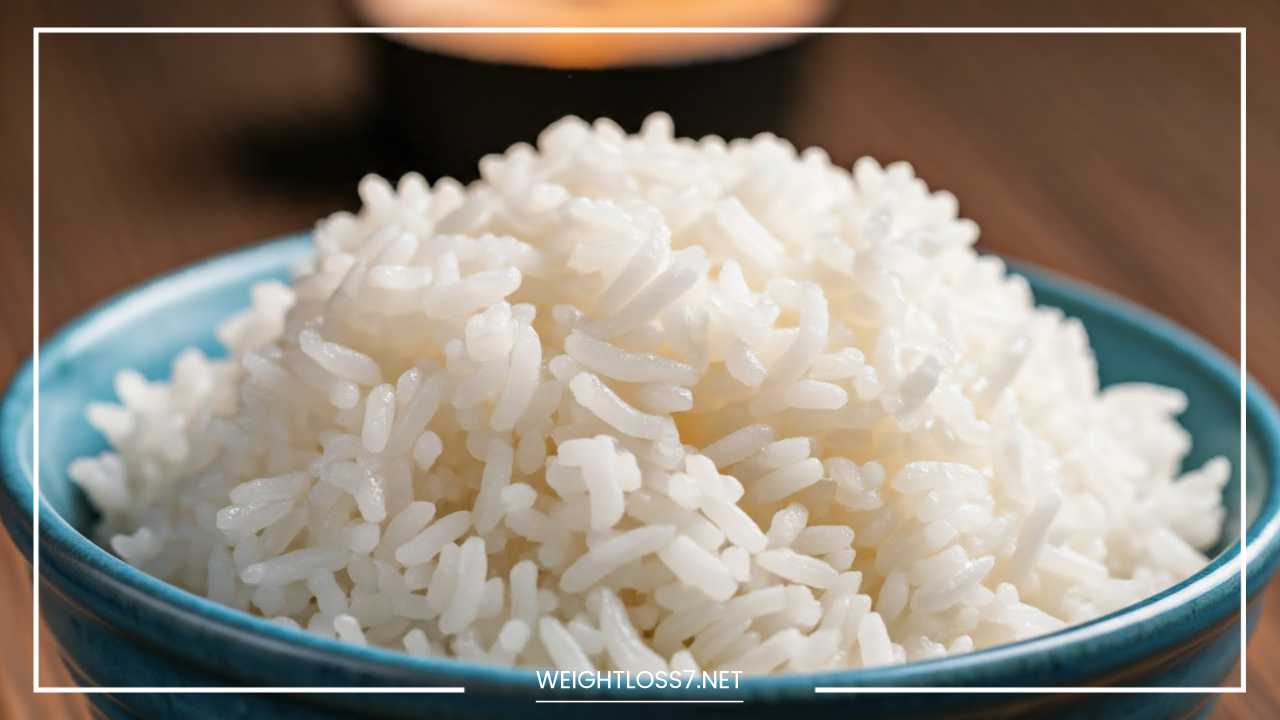Is Rice Healthy?

Is Rice Healthy
Is Rice Healthy for You?
Rice is a staple food for billions of people worldwide, serving as a foundation for meals in numerous cultures. Its affordability, versatility, and ability to pair with a myriad of ingredients make it a beloved choice in countless dishes.
However, as public awareness about nutrition increases, many people are reevaluating the role of rice in their diets.
This comprehensive guide will delve deeply into the nutritional composition of rice, explore its potential health benefits and risks, and provide practical tips for incorporating it into a balanced diet.
Nutritional Composition of Rice
Rice is primarily made up of carbohydrates, specifically complex carbohydrates, which are essential for providing energy.
Beyond carbohydrates, rice contains several important nutrients, though the composition can vary significantly depending on the type of rice and how it is processed and cooked.
1. Carbohydrates
Rice is predominantly a source of carbohydrates, primarily in the form of starch. The digestible starch in rice provides a quick and accessible energy source, making it a go-to food for athletes and those engaged in physical activities. The carbohydrate content can vary between different rice types:
- White Rice: Approximately 28 grams of carbohydrates per 1 cup (cooked).
- Brown Rice: About 24 grams per cup, but with added fiber benefits.
2. Vitamins and Minerals
Rice is also a source of various vitamins and minerals:
- Vitamins:
- Thiamine (Vitamin B1): Important for carbohydrate metabolism and nerve function. One cup of cooked brown rice provides about 12% of the daily value (DV).
- Riboflavin (Vitamin B2): Essential for energy production and skin health.
- Niacin (Vitamin B3): Supports the digestive system and skin health. Brown rice is particularly rich in niacin, offering about 15% of the DV per cup.
- Folate (Vitamin B9): Crucial for DNA synthesis and cell division, especially important during pregnancy.
- Minerals:
- Iron: Vital for oxygen transport in the blood. Brown rice provides about 5% of the DV per cup.
- Magnesium: Important for muscle function and energy production, with about 21% of the DV found in a cup of brown rice.
- Phosphorus: Essential for bone health and energy production.
- Potassium: Helps regulate blood pressure and fluid balance.
3. Fiber Content
The fiber content in rice is a significant differentiator between white and brown rice:
- White Rice: Low in fiber due to the milling process that removes the bran and germ. It typically contains less than 1 gram of fiber per cup.
- Brown Rice: A whole grain that retains the bran and germ, offering about 3.5 grams of fiber per cup. The increased fiber content promotes digestive health and contributes to a feeling of fullness.
4. Other Nutrients
Rice also contains phytochemicals, such as phenolic compounds, which have antioxidant properties. Additionally, fortified rice can provide extra nutrients, such as iron and folic acid, enhancing its health benefits, especially in populations at risk of deficiencies.
Potential Health Benefits of Rice
Rice is often celebrated for its many potential health benefits. While its nutritional composition suggests that it can play a significant role in a healthy diet, it is essential to consider how different varieties can influence overall health.
1. Energy Source
Rice is an excellent source of energy, making it particularly beneficial for those with active lifestyles. The carbohydrates in rice provide a steady source of glucose, which fuels the body’s functions.
This energy source is essential for athletes, who require ample carbohydrates for performance and recovery. Eating rice before or after exercise can help replenish glycogen stores, aiding in energy recovery.
2. Weight Management
When consumed in moderation, rice can fit into a healthy weight management plan. The fiber found in brown rice can help increase feelings of fullness, potentially reducing overall calorie intake.
This is particularly advantageous for individuals looking to maintain or lose weight. Additionally, the low calorie density of rice allows for satisfying portion sizes without excessive calorie consumption.
3. Heart Health
Several studies suggest that brown rice consumption may be linked to lower blood pressure and a reduced risk of heart disease. The fiber, vitamins, and minerals found in brown rice can contribute to cardiovascular health:
- Cholesterol Regulation: The soluble fiber in brown rice can help lower LDL (bad) cholesterol levels, reducing the risk of heart disease.
- Blood Pressure Management: Potassium in rice helps manage blood pressure by counteracting sodium’s effects and promoting vascular health.
4. Digestive Health
Brown rice is a good source of dietary fiber, which plays a crucial role in digestive health. Fiber promotes regular bowel movements and helps prevent constipation by adding bulk to the stool.
Furthermore, the fiber in brown rice supports gut health by serving as a prebiotic, nourishing beneficial gut bacteria and potentially enhancing overall digestive function.
5. Nutrient-Rich Food
Rice can be a good source of essential vitamins and minerals, particularly when fortified. In many countries, rice is often enriched with nutrients like iron and folic acid, addressing nutritional deficiencies in populations that rely heavily on rice as a staple.
This fortification can significantly enhance the health benefits of rice, especially for vulnerable groups such as pregnant women and children.
6. Gluten-Free Alternative
Rice is naturally gluten-free, making it a safe and nutritious option for individuals with celiac disease or gluten sensitivity.
It can serve as a versatile base for meals, providing a satisfying alternative to wheat-based products. This quality has made rice increasingly popular in gluten-free diets, allowing individuals to enjoy a wide range of dishes without compromising their dietary needs.
Potential Risks and Considerations
While rice offers numerous health benefits, it also poses certain risks that should not be overlooked. Understanding these potential downsides is essential for making informed dietary choices.
1. Arsenic Concerns
One of the most significant health risks associated with rice consumption is arsenic exposure. Rice, especially varieties grown in certain regions, can absorb arsenic from the soil and water, which can accumulate over time.
Long-term exposure to arsenic is associated with various health issues, including cancer and cardiovascular diseases. To minimize the risk of arsenic exposure, consider the following:
- Choose Low-Arsenic Varieties: Basmati rice from India or Pakistan and jasmine rice from Thailand tend to have lower arsenic levels compared to other types.
- Rinse Rice Thoroughly: Rinsing rice before cooking can help remove some of the surface arsenic. This process also helps reduce excess starch.
- Soak Rice: Soaking rice for 30 minutes or longer can significantly lower arsenic levels, making it safer for regular consumption.
2. Glycemic Index and Blood Sugar Levels
White rice has a high glycemic index (GI), meaning it can cause rapid spikes in blood sugar levels. This can be a concern for individuals with diabetes or insulin resistance.
Consuming high-GI foods may lead to increased hunger and cravings, potentially contributing to weight gain. In contrast, brown rice and other whole grains have a lower GI, providing a more gradual release of glucose into the bloodstream.
3. Caloric Density and Overconsumption
While rice can be a part of a balanced diet, it is important to monitor portion sizes. Overconsumption, particularly of white rice, can lead to excessive calorie intake and potential weight gain.
A typical serving of cooked rice is about half a cup, and it’s advisable to pair rice with plenty of vegetables and lean proteins to create a well-rounded meal.
4. Potential Nutritional Deficiencies
Relying too heavily on rice as a staple can lead to nutritional deficiencies, especially if it replaces other nutrient-dense foods.
While rice provides essential carbohydrates, its low fiber and vitamin content (particularly in white rice) can limit dietary diversity.
It is important to balance rice consumption with other grains, fruits, vegetables, and protein sources to ensure adequate nutrient intake.
Incorporating Rice into a Balanced Diet
To maximize the benefits of rice while minimizing potential risks, here are practical tips for incorporating it into a healthy diet:
1. Opt for Whole-Grain Varieties
Choosing whole-grain varieties like brown rice, wild rice, or black rice is one of the best ways to enhance the nutritional value of your meals.
These varieties are higher in fiber, vitamins, and minerals compared to white rice and have a lower glycemic index, making them a healthier choice overall.
2. Experiment with Cooking Techniques
Cooking techniques can significantly impact the nutritional profile of rice. To retain nutrients and enhance flavor:
- Cook with Broth: Using vegetable or chicken broth instead of water can infuse rice with additional flavor and nutrients.
- Avoid Overcooking: Cook rice until it is tender but not mushy to retain its texture and nutritional value.
3. Rinsing and Soaking
Always rinse rice before cooking to remove excess starch and lower arsenic content. Soaking rice for 30 minutes or longer before cooking can further reduce arsenic levels and improve its digestibility.
4. Diversify Your Grains
Incorporating a variety of whole grains into your diet can provide a wider range of nutrients and textures. Consider rotating rice with quinoa, barley, farro, millet, or other grains. This not only enhances nutrition but also keeps meals interesting and flavorful.
5. Mind Your Portions
Be conscious of portion sizes. A typical serving of cooked rice is about half a cup. This serving size is generally sufficient when paired with a variety of vegetables and lean proteins. If you’re using rice as a side dish, aim for it to comprise about one-quarter of your plate.
6. Pair Rice with Nutrient-Dense Foods
To enhance the nutritional profile of meals, pair rice with a variety of nutrient-dense foods. Incorporating vegetables, legumes, lean proteins, and healthy fats can create a balanced plate that provides essential nutrients and supports overall health.
For example, a stir-fry with brown rice, mixed vegetables, and tofu or chicken can be a satisfying and nutritious meal.
7. Practice Mindful Eating
Being mindful of your eating habits can enhance your relationship with food. Pay attention to portion sizes, savor the flavors and textures of your meals, and listen to your body’s hunger cues.
This approach can help prevent overeating and promote a healthier relationship with food.
Final Thoughts
In conclusion, rice can be a nutritious and versatile food that plays an essential role in many diets around the world.
Its complex carbohydrates provide a reliable energy source, while the vitamins and minerals it contains contribute to overall health.
By choosing whole-grain varieties, employing proper cooking methods, and being mindful of portion sizes, you can enjoy rice as a healthy component of your meals.
Understanding the nutritional profile, potential benefits, and risks associated with rice allows you to make informed dietary choices that support your health and wellness goals.
Whether you enjoy it as a base for a hearty stir-fry, in a comforting risotto, or as part of a refreshing rice salad, rice can fit seamlessly into a balanced diet.
Embrace the diversity of rice varieties and cooking techniques, and explore how this ancient grain can continue to nourish you in a modern world.

















